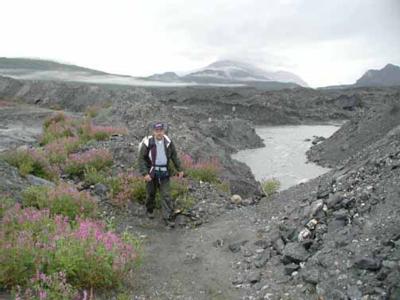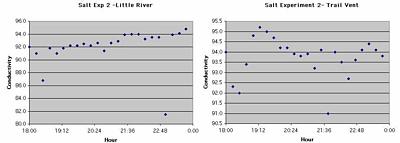11 July, 2000
July 11, 2000
Matanuska Glacier, Alaska
A cold dreary morning did not dampen our enthusiasm as we hiked out to
retrieve the samples that were collected last night by the two ISCOs.
Along the way to both the Trail Vent and Little River Vent I was hopeful
that the ISCOs had collected our samples without any problems. Both
stations came through for us and we made our way back to camp to test
each of the forty eight samples and examine the results.
With access to two conductivity meters Ben checked the Trail Vent
samples and I worked with those from Little River Vent. We worked very
quietly and didn’t have much conversation. I think both of us were deep
in thought about what we were seeing as we moved from bottle to bottle.
For my part I was mostly seeing a rather constant value show up in each
sample. But then I began to see a change in the values. Could this be
it? The values had been fluttering about 92 microsiemens for about three
hours but quickly the values went up and hovered around 94. Was this
significant? I remained quiet and kept testing each successive sample.
We happened to finish at about the same time and began to discuss what
we were seeing in the results. We both had conductivities in the same
general range but neither of us saw a significant change in them. Was
there anything in the data that would suggest that we’d found a
connecting moulin/vent pair? I suggested we put the data into a
spreadsheet and look for patterns or trends in the data.
We quickly got the data entered and graphed. Hmmmm..... Try to be
objective here.....
It seems you can always take given information and make it say what you
want it to say. It is very tempting to do so yet always foolish to jump
to a conclusion from just a single experiment and one set of data. Even
though it appears that something could be said from this data there are
still some issues that need to be looked at. One issue we discussed is
how did the rain influence the results. It ought to dilute the samples.
If not for the rain would there have been more pronounced changes? We
originally had hoped to take advantage of the low flow during the night
time period to reduce dilution. Does the conductivity normally have
fluctuations of a couple digits? We took samples over a very short
period of time. Perhaps we just saw small bits of natural fluctuations
in conductivity. Maybe we ought to toss in even more salt in order to
make a more pronounced spike, if indeed we are getting one.
We decided to take samples again tonight but without dumping salt. This
will provide some idea of the “normal” conditions. Provided the weather
conditions seem similar, we will then repeat this tomorrow night with
salt. Perhaps then we can go a bit further in determining a connection
between our moulin and the vents.
This afternoon we worked a bit with the centrifuge that we’ll use to
quickly settle out the sediment in our samples. This is not necessary
for our conductivity measurements but is essential once we start using
the fluorometer. The presence of suspended sediment (cloudiness) in the
sample prevents the fluorometer from obtaining accurate readings.
Hopefully it won’t be long before we make our connections and can
proceed with the dye tracing phase of the project. In the meantime we
want to be sure that all equipment is ready to go when the time comes.
Marvin Giesting

Checking the conductivity of the samples in the ISCO rack.

Hiking back from Little River Vent with the ISCO samples.

The graphical results from our first samples.Could the rise near 21:00 hours be a very dilute spike at Little River? Did Trail Vent spike early and then taper off? Perhaps these fluctations are typical. Trail Vent is much closer to the moulin than Little River Vent. We will watch for a similar pattern in our next run with salt.
Contact the TEA in the field at
.
If you cannot connect through your browser, copy the
TEA's e-mail address in the "To:" line of
your favorite e-mail package.
|
